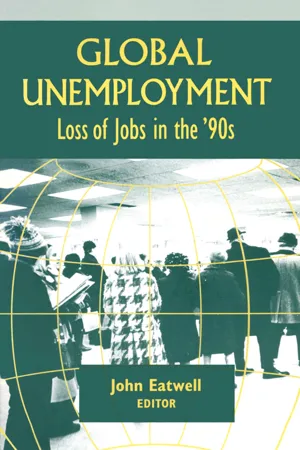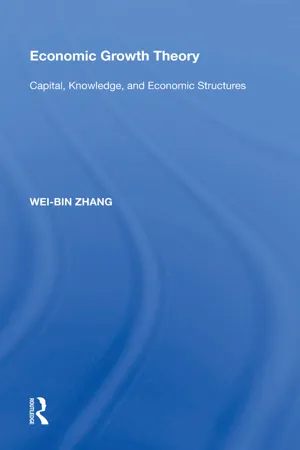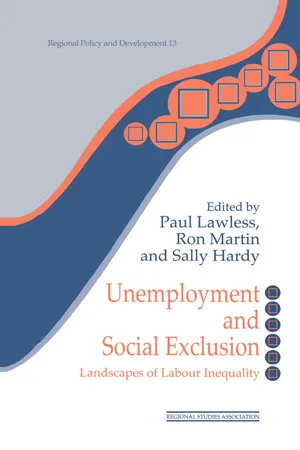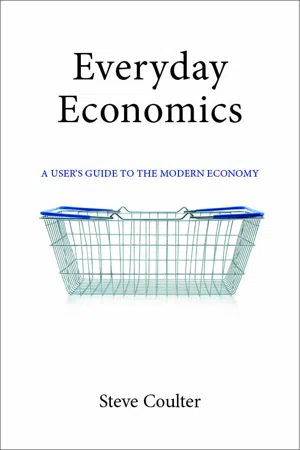Economics
Trade and Unemployment
Trade can impact unemployment by affecting the demand for domestic goods and services. Increased imports can lead to job displacement in industries facing competition from foreign producers, potentially contributing to higher unemployment. However, trade can also create employment opportunities through export industries and the overall expansion of the economy.
Written by Perlego with AI-assistance
Related key terms
Related key terms
1 of 4
Related key terms
1 of 3
6 Key excerpts on "Trade and Unemployment"
- eBook - ePub
The Problem of the Unemployed (Routledge Revivals)
An Enquiry and an Economic Policy
- J. Hobson(Author)
- 2013(Publication Date)
- Routledge(Publisher)
In estimating the returns of “unemployed” by the textile, the mining, and other industries, it must be borne in mind that many of the strongly organised trades distribute the loss of employment among all their members, instead of allowing some to become wholly unemployed, working short time instead of allowing a reduction of the number employed. One of the chief objects in the practical programme of many trade unions is the arrangement with employers to work short time so as to avoid unemployment. This, of course, introduces an element of genuine “unemployment” as measured in superfluity or waste of labour-power, which is not returned in the statistics of “unemployed.” If all the members of a trade work half time for a period, in any scientific measurement this must reckon at 50 per cent, unemployed. The amount of economic “unemployment” due to this cause is growing all the time as trade organisations become stronger and are able to bring pressure on the employers to distribute a spell of bad trade so as to inflict least injury to the body of workers.It is then certain that, even among the trade unions whose figures form our basis of calculation, the actual amount of unemployment is greater than is reported.§6. A Larger Figure for Non-unionists.
If we turn to the further question, how far the condition of the trade union is a just indication of the condition of the whole trade, we shall, I think, be driven to conclude that unemployment is greater among non-unionists than among unionists.In most cases, the members of trade unions must be regarded as the pick of their trade in skill, strength, character and intelligence ; and one chief economic object of trade unionism is to secure as far as possible a monopoly of regular well-paid employment for its members, limiting membership by the test of capacity to earn a standard wage. In a period of slack or depressed trade the trade unionist, both by virtue of personal efficiency and by the strength of his union, is more likely to retain employment than the outsider. The less efficient members of a union, whose employment is less secure, fail, in slack times, to keep up their weekly subscriptions, and drop out of the union, whose official report takes no account of them as “unemployed.” It is true that against this we must set the ability of the non-unionist to hold his work by a readier acceptance of lower wages. Moreover, as he has no “unemployed benefit” to fall back upon, he will often be driven to take what casual labour of any sort he can get. In measuring the chances of “unemployment,” these probabilities must be set against the superior position of the union man; but taking the term “unemployed” as commonly applied to members of a skilled trade, we must without doubt expect to find a larger percentage of “unemployed” among non-unionists than among union members. - eBook - ePub
Coping with Global Unemployment
Putting People Back to Work
- John Eatwell(Author)
- 2016(Publication Date)
- Routledge(Publisher)
_________4_________ Free Trade, Unemployment, and Economic Policy Anwar M. Shaikh It is now widely recognized that a country’s ability to compete effectively in the world market can be vital to its long-run prospects. Of course, in the short and medium run a country can protect itself from international competition through a variety of devices. Outright protection in the form of tariffs, quotas, and even subsidies can help insulate individual industries or regions. Manipulation of the exchange rate can enhance the competitiveness of national industries vis-à-vis the corresponding world sectors. And manipulation of the interest rate can induce foreign capital inflows and thus help cover any existing trade deficits. But in the long run, it seems, the issue of international competitiveness must be faced squarely. Crucial questions are: how does opening up a country to international competition through free trade affect its levels of production and employment? Does free trade equalize competitive advantages, or does it worsen existing inequalities? Is laissez-faire the best way to participate in international trade, or is some degree of state support and management preferable? The questions are age-old ones, and they involve both theoretical and policy considerations. To answer them adequately, we must address the actual workings of the capitalist world market. This means examining not only the immediate effects of international trade, but also the longer-term consequences, the ones that assert themselves through a slow and steady alteration of the initial effects, or by giving rise to unexpected or even unacceptable side effects. Successful policy therefore requires a structural analysis of international competition and the world market - eBook - ePub
Economic Growth Theory
Capital, Knowledge, and Economic Stuctures
- Wei-Bin Zhang(Author)
- 2018(Publication Date)
- Routledge(Publisher)
Chapter 7 Growth, Unemployment and WelfareOne of the basic questions in economic theory is why modern economies are incapable of employing, fully and efficiently, their available resources. Unemployment of labor force seems to attract a greatest attention of researchers. Unemployed men cost society dearly. They may diminish their human capital through different kinds of 'depreciation'. A high rate of unemployment is often associated with social unrest and high crime rates. Unused physical capital causes less attention than unemployed people perhaps because the former does not cause social troubles. In many countries, high unemployment is persistent. In 1995, for instance, the proportion of unemployed workers who had been unemployed for more than a year exceeding 30 percent in most European countries. It is one thing to be unemployed for a few days or even a few months; but quite another to be unemployed for a few years. Those who become long-term unemployed end up losing skills and work habits.The history of economic theory shows that it is not an easy matter to theoretically explain growth with unemployment. Speed of changes in variables varies according to institutions and cultural environment. The Walrasian economics assumes instantaneous adaptation of labor market to its equilibrium. In reality, friction exists everywhere; but non-frictional motion is rarely observed. A frictional factor in labor market is the existence of long-term relationships between firms and workers. Many jobs involve long-term attachments and considerable firm-specific skills on the part of workers. For instance, lifetime employment practice in Japanese companies means that market mechanism will not work smoothly in Japanese labor market. Workers would stay in their current jobs even when they are offered some better work, probably short-run, opportunities. Since Adam Smith, there has been a long-traditional belief in economics that freely competitive market can supply the most efficient co-ordination mechanism in optimal allocation of resources. We followed this traditional belief in the previous chapters, showing how market forces should be able to harmonize a number of individual decisions and lead to optimal allocation of resources. In examining free economies we allowed neither 'fixed wages' like in the Keynesian economics, nor 'a generous social welfare policy' (which may give incentives for some people to be in unemployment state) for unemployed people by the government, nor a mere 'survival wage' rate like in the Marxian economics, nor friction of structural adaptations in changeable knowledge-oriented economies. It is obvious that if we allowed any of these actually possible situations to exist in our theoretical models, we could not guarantee full employment as in the previous chapters. This chapter is concerned with economic dynamics with unemployment. We propose some models to analyze complex of economic evolution with unemployment. It should be noted that the models in this chapter are not inconsistent with the rest of the book in the sense that if we allow the fixed factors to be determined by market mechanisms, then the models in this chapter converge to the models in the rest of the book, and vice versa. - eBook - ePub
Unemployment and Social Exclusion
Landscapes of Labour inequality and Social Exclusion
- Sally Hardy, Paul Lawless, Ron Martin(Authors)
- 2013(Publication Date)
- Routledge(Publisher)
The ‘natural rate’ will be high when the market-clearing process takes time and proceeds inefficiently, when public policies remove the incentive to adjust and adapt, and when the labour force is ageing. It will also be high if public policy holds wages above the competitive level which would be set in the market-place, for example, as the result of minimum wage provisions or the protection afforded by wage councils. Furthermore, the natural rate of unemployment will be high when trade unions use their monopoly power to press for and obtain higher wages than would be set in ‘free’ labour markets. In sum, the more that labour markets deviate from the competitive ideal, the higher will be the natural or equilibrium unemployment rate.Unemployment as choice places the emphasis on the individual. The unemployed can find a way into work by demonstrating a willingness to accept lower wages, less attractive working conditions, longer journeys to work or by transferring to other occupations, industries and locations. Insufficient flexibility results in unemployment ‘by choice’. The counter revolution represents the relationship between employer and employee as remarkably shallow. The loss of job security for an individual, the loss of a way of life for a community are depoliticised and described in a way that minimises their consequences. Unemployment is seen as a voluntary choice or as the result of government policies that provide incentives to workers to remain unemployed. The new view of unemployment also emphasises productive search, transitional (brief) unemployment and selective choice. These are always part of unemployment. The question is how important these features actually are in explaining high and rising unemployment in the 1970s, 1980s and 1990s (see MacKay 1993 ; MacKay and Jones 1989 ).The evidence shows that the number of people moving between jobs declines, and voluntary quits (a proxy for productive job search) fall as unemployment climbs. There is a tendency for workers to hold on to their existing jobs (even if they are not entirely satisfactory) in difficult labour markets. When labour markets are tight, transfer between jobs is high and movement is predominantly voluntary; when labour markets are slack, transfer is reduced and voluntary quits account for a declining proportion of job separations. Choice, experiment and productive job search decline in significance as unemployment climbs: they cannot explain high and rising unemployment. - eBook - ePub
Everyday Economics
A User's Guide to the Modern Economy
- Steve Coulter(Author)
- 2017(Publication Date)
- Agenda Publishing(Publisher)
But are these wage differentials fair? Mainstream economics tends to dodge these arguments, as it is primarily concerned with efficiency, not equity, and fairness is something best dealt with by elected politicians. Critics of high wages in football note the correspondingly high ticket prices for games, however, which price out many supporters on low incomes, and point out that a maximum wage operated in England until the 1960s without noticeably discouraging talented players into the game. In more everyday workplaces there is legislation and company policy to enforce fairness in wages, for example ensuring equal pay for men and women. The presence of trade unions may also blunt the impact of the market and dampen pay differentials between workers.It seems fair to say, therefore, that markets are important in many aspects of our everyday lives, and this includes the world of work. But markets are embedded in a society replete with social tensions over wealth and one that is, furthermore, governed by politicians who respond to demands for fairness and equity. This will tend to produce a lot of distortions into the market, and it is to these that we turn next to consider.3.2 Unemployment and the macroeconomics of labour markets
Labour markets are different from other markets in that workers are not passive objects, such as a car or tablecloth. This makes them more complex. A worker may intensify her efforts if she likes her job, respects or fears her boss or is paid a higher wage for better performance. Workers in some industries may organize to create or join trade unions, which may push up the wage of the whole firm or industry. And, ultimately, wages not saved are spent, so they form the basis of consumption and are an important source of the demand that keeps the economy going. What this means, therefore, is that the NCE view of labour markets explored in the first section gives only an incomplete picture of the world of work and employment and one laden with a lot of assumptions.The main assumption is that an individual’s job search take place in what is essentially a well-functioning market. For example, the job market is assumed to be transparent, as workers know about wages and job opportunities elsewhere in the economy, and employers can pick and choose among candidates to find the best one for the job. But we know from the economics of information that this is not particularly realistic. Around a third of jobs are not advertised but are filled through word of mouth, giving a huge advantage to insiders and placing new job seekers, such as young people leaving school or university, at a disadvantage. - eBook - ePub
- William H. Beveridge(Author)
- 2014(Publication Date)
- Routledge(Publisher)
153. With growing knowledge of the facts of unemployment, acquired through practical dealing with unemployment, has gone much hard thinking and theorizing by economists. The review of facts in the first section is followed by a review of theories in the second section, and then by a third section, showing how facts and theories converge to demonstrate the need for action and the kind of action that is needed. The new face of unemployment in Britain, as in the United States, is grimmer than the old face. But unemployment to those who will face the facts and examine the theories is no longer a hopeless mystery. The time has come for deciding to let action follow understanding.SECTION I. FACTS OF UNEMPLOYMENTUNEMPLOYMENT BEFORE 191454. Before the first World War, the most valuable and the only continuous record of facts about unemployment in Britain was that supplied by trade unions giving out-of-work pay to their members when unemployed. The trade union returns, at their highest before 1914, covered less than a million workpeople nearly all of whom were skilled men, but they represented a considerable variety of occupations. The returns were made monthly and gave both the total membership and the members unemployed, making it possible to obtain the percentage of the membership unemployed in each union, in all the unions in a particular industry, and in all unions taken together. From these returns a general percentage of unemployment was calculated and is available for each month from 1888 to 1926; by a special enquiry whose results were published in 1904,1 the Board of Trade, at that time the Government Department responsible for labour questions, were able to calculate annual unemployment percentages for a number of unions as far back as 1851. Out-of-work pay developed first in the engineering, shipbuilding and metal industries, which were particularly liable to violent fluctuation, so that the early figures related mainly to these industries, while other industries came into the returns gradually; engineering, shipbuilding and metals accounted for about three-quarters of the total membership covered by the returns in 1860–70 and about two-fifths in 1904. In order to keep the figures, so far as possible, on the same basis throughout, the Board of Trade used, as the most general indication of level of unemployment, the mean of the percentage for the engineering, shipbuilding and metal industries, and of the percentage for all other industries taken together; they described this as the “corrected” unemployment percentage. This corrected percentage is available for each year from 1856 to 1926 and is used here for all general purposes.2
Index pages curate the most relevant extracts from our library of academic textbooks. They’ve been created using an in-house natural language model (NLM), each adding context and meaning to key research topics.
Explore more topic indexes
Explore more topic indexes
1 of 6
Explore more topic indexes
1 of 4





